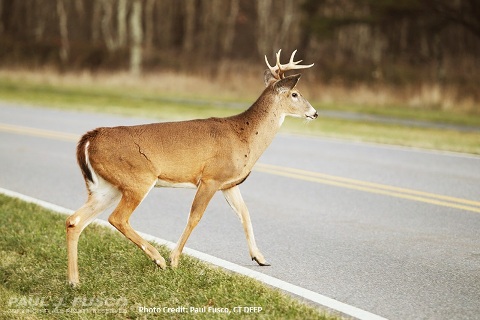
Autumn in Connecticut means mating season for whitetail deer and an increased risk of collisions with your vehicle. Make sure you're protected with the right type of insurance and understand how to prevent animal accidents.
The National Highway Traffic Safety Administration estimates that damage caused by deer accidents results in over $1 billion in annual insured losses.
The Federal Highway Administration reports approximately 300,000 reported collisions between cars and large animals. Including unreported crashes each year, the total number is more likely between one and two million annually. Of the reported crashes, approximately 26,000 resulted in human injuries and 200 resulted in human fatalities per year.
The Connecticut Insurance Department offer the following tips:
Are Your Covered?
- Damage to a vehicle from an animal strike is covered under an auto policy's optional comprehensive portion. If you have liability only coverage or liability with collision coverage, your insurance carrier will not cover damage to your vehicle resulting from an animal strike. If you want to make sure your vehicle is covered for damage from an animal strike, contact your agent or carrier to discuss adding comprehensive coverage to your policy.
- Comprehensive auto insurance also includes coverage for a variety of perils/risks/exposure: fire, theft, vandalism or malicious damage, riot, flood, earthquake or explosion, hail, windstorm and falling or flying objects.
- Filing a claim for an accident covered by your comprehensive coverage means you'll still need to pay a deductible. After that, your insurer will cover the costs of the claim up to your policy limits.
How to Avoid an Animal Collision?
Consider these tips to help reduce your chances of an animal collision:
- Deer tend to travel in herds, so if you see one, lookout for more that may follow.
- Keep an eye out for deer signs. They are placed at known deer-crossing areas. Reduce your speed when you see a sign.
- Animals tend to be active during dawn and dusk so be extra-conscious during these times. Stay cautious and watch your speed.
- Make sure your headlights are in working order to ensure you see well at night. Using high beams can help you spot wildlife but be considerate of other drivers when using them.
- Stay focused while driving. Do not text, talk on your phone or allow passengers to distract you.
- Always wear your seat belt. This won't prevent a collision but it can save your life depending upon the severity of the accident.
What to do After an Animal Accident?
Some accidents are unavoidable. Knowing how to react in the event of an animal collision can help keep you safe. If you are about to hit a deer, hold firmly onto the steering wheel, apply your brakes and come to a stop. If you can't avoid a collision, try not to swerve. If you swerve, you could lose control and hit a tree or veer into oncoming traffic. After a collision with an animal, follow the steps below:
- Stay calm.
- If you can, move your vehicle to a safe place and turn on your hazard lights. This may mean pulling over to the shoulder of the highway.
- Stay away from the animal. A frightened or wounded animal can lash out and hurt you.
- If you can't move your car, or the animal carcass is blocking traffic, alert the authorities so they can clear the roadway.
- Document the incident by taking photos of your vehicle damage, the roadway and any injuries sustained.
- Check to see if your vehicle is safe to operate. Check for leaking fluid, damaged lights, loose parts or other safety hazards. When in doubt, call a tow truck.
For help with all your insurance issues and get answers to your questions, contact the department by:
- Email us at insurance@ct.gov
- Ask a question or file a complaint online
- Call the Consumer Helpline at 800-203-3447 or 860-297-3900.
- Sign up for e-alerts to get the latest news, warnings and rate changes that may affect your premium
- Download consumer FAQs on health, homeowner and auto coverage
- Visit our Web site and follow the Department on Facebook, Twitter or YouTube

